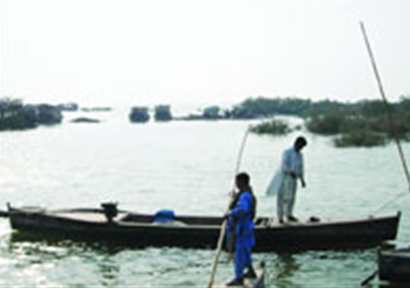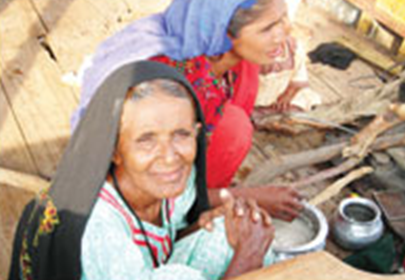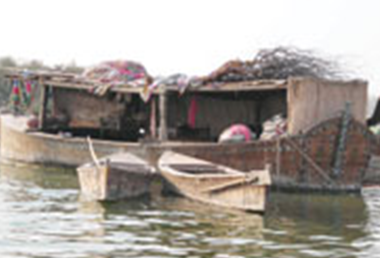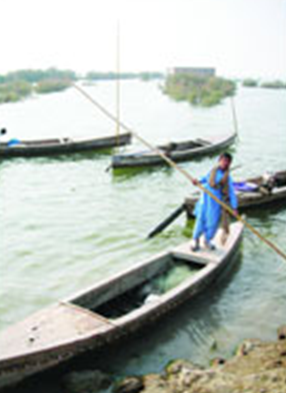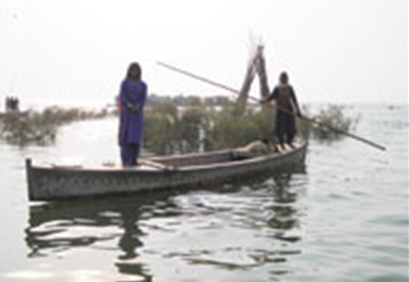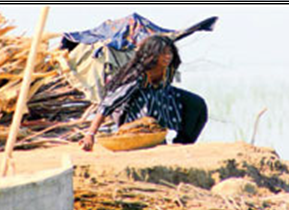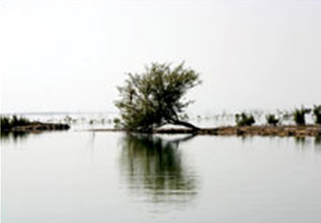Manchar Lake/ Mohannas
This is a collection of articles archived for the excellence of their content. Readers will be able to edit existing articles and post new articles directly |
Contents |
Manchar Lake/ Mohannas
Asia’s largest toxic lake
By Rina Saeed Khan
Manchar Lake was once a tourist destination, a wetland that was a haven for migratory waterfowl and home to a thriving community of Mohannas and agriculturalists who raised crops around the lake’s shallow bed. Over the years, shortage of rains and the influx of chemical effluents have started playing havoc with the lake and its people
We arrived as the sun was setting and Manchar Lake certainly looked picturesque, shimmering in the fading light. A few Mohannas (local fishermen) were straining at the bamboo poles on their wooden boats, pushing them soundlessly in the water as they made their way home. The lake stretches for miles in every direction and one can barely see the opposite shoreline. It is more like a mini-sea than a lake.
Manchar Lake is Pakistan’s biggest shallow water natural lake. Located at a distance of about 18 kilometres from Sehwan Sharif, district Dadu in Sindh, it is a vast natural depression surrounded by the Kirthar hills in the west, the Laki hills in the south and the River Indus in the east. Only around 10 feet deep, it is hard to believe that beneath its smooth, silvery surface, the lake water is full of toxins which have chased away migratory birds, destroyed the local agriculture, devastated the Mohanna community and killed people living in nearby cities.
The very mention of Manchar Lake still brings up memories of the summer of 2004, when hundreds of people in Hyderabad and further down the River Indus, fell ill after drinking poisonous water from Manchar Lake that had been allowed to enter the city’s water supply.
Around 40 people, mostly children, died from severe diarrhoea caused by gastroenteritis in Hyderabad alone. The lake’s waters reached the city via the River Indus, due to the heavy rains that had broken a long period of drought in Sindh. A fact-finding report conducted by Pakistan’s Human Rights Commission squarely blamed the lake’s toxic water for the disaster.
This year, Manchar Lake was again full of water –– it had rained heavily in 2006 and the lake is fed mostly by hill torrents. According to a report on the lake conducted by Naseer Memon, an environmentalist, “Inflow to the lake is very erratic and unreliable since it depends on flood flows. Annual rainfall in this area is only 4.43 inches (112.5mm) against evaporation of about 80 inches (2000mm). Therefore, very little runoff is generated within catchments of hill torrents during dry or average years. Hence the lake is recharged by this source only during wet years, which normally occur once in three years.” The other main source of freshwater for the lake is River Indus, but the river itself is facing water shortages.
There was even a sizeable amount of fish for sale in the small marketplace located in the settlement on the banks of the lake, as we got off the main road from Sehwan Sharif. This settlement consists mostly of mud houses and a bazaar which reeked of rotting fish and open sewers.
We were more interested in meeting the Mohannas or traditional fisher folk, who still live in their wooden houseboats, as they have for centuries, in harmony with their natural environment. Only now, has environment turned against them. “We used to be more than 60,000 in number, living here on the lake. Now there are only 10,000 of us left. Most families moved because they were starving here. The water is spoilt –– the natural vegetation in the lake has gone, the fish have died mostly –– there is nothing here for us now. We would leave tomorrow if we could, but we have no money at all,” explained Nazeer, a Mohanna who lives with his close relatives. All of them make up a cluster of eight boats.
These large houseboats are mobile homes for the community and a peak inside one revealed bedding, a makeshift kitchen, shelf space for storing food, household items and a cradle.
Manchar Lake is Pakistan’s biggest shallow water natural lake. Only around 10 feet deep, it is hard to believe that beneath its smooth, silvery surface, the lake water is full of toxins which have chased away migratory birds, destroyed the local agriculture, devastated the Mohanna community and killed people living in nearby cities
According to Nazeer, the water in the lake started turning bad around eight years ago, probably when the six-year drought hit Sindh. Manchar Lake was once a tourist destination, a wetland that was a haven for migratory waterfowl and home to a thriving community of Mohannas and agriculturalists who raised crops around the lake’s shallow bed. Over the years, shortage of good rains and the influx of chemical effluents have started playing havoc with the lake.
“Manchar is badly hit by the construction and enlargement of the artificial channels linking the Indus with the lake and the construction of flood embankments to the north. The Main Nara Valley Drain (constructed during the building of Sukkur Barrage) brings a considerable supply of saline water into the lake,” points out Memon.
To make matters worse, the controversial and badly designed Right Bank Outfall Drain (as the remodelling of the Main Nara Valley Drain is now called) began dumping industrial effluents (from factories up north) and agricultural runoff into the lake. The authorities assumed freshwater from the Indus and from the hill torrents during the rainy season would dilute the effluents.
That was a miscalculation, for Manchar’s two sources don’t provide it with enough water to clean the effluents. Flows from the Indus are drying up because of barrages and dams located upstream, while rainfall in Sindh is becoming extremely erratic in recent years due to climatic changes.
According to water experts, Manchar Lake now has a 4000-ppm salt concentration and people who drink its waters can get water-borne diseases and develop serious illnesses in the long run. Environmentalists want the present drainage from the Right Bank Outfall Drain into Manchar Lake to be stopped immediately.
Almost 100,000 acres of land in Sindh is irrigated by waters from Manchar Lake. Imagine all the crops and vegetables absorbing the toxic chemicals in the water from effluents discharged from factories and agricultural runoff. Those crops and vegetables are probably harvested and sold in towns and cities all over the province. Hard chemicals get into the food chain and cause cancer in human beings.
The Mohannas themselves are not taking any chances with the polluted lake water. They buy their drinking water from the bazaar and store it in large plastic containers on their houseboats. The livestock in the area, however, which drinks from the lake, is infected with all sorts of diseases. Although the plight of the Mohannas has been highlighted in the media in recent years, they complain that they still don’t get any help.
“Trucks come with relief goods and food items, but we don’t get anything. The people living on the shore take it all –– especially all those so-called NGOs. No one helps us,” complains a Mohanna.
We visited the houseboats, many of which were inhabited by women and noticed that there were hardly any men around. “Most of the young men have gone to the coast to find work. Mostly, women, children and old people are left here now. It is the same situation all over the lake. Those who can, migrate to greener pastures,” says an old woman as her daughter lights up a fire on their houseboat to cook the evening meal. “We have lived on this lake for almost seven generations –– but now I don’t see much of a future here for us.”
By now it was getting dark, so we made our way to the shore –– a man was getting ready to butcher a duck he had caught on the lake that day. In the past, the lake was the winter home to numerous migratory bird species. Since it was the first wetland on their route, Manchar Lake was a safe wintering home for thousands of migratory waterfowl. Wildlife experts say that the pollution in the lake has caused a drastic fall in their numbers. Migratory birds still visit the lake, but fly off after an overnight stay.
On our way back to the main road where our car was parked, we noticed a number of small children carrying wood. The Mohannas told us that selling fuel wood in the bazaar is now one of their main sources of income. One little girl was bent over, carrying a large bundle of wood on her head, her clothes no more than rags. There are no schools in the area. Amongst the fisher folk communities, 90 per cent of boys and 95 per cent of girls have never been to school.
Nevertheless the local communities have other, more immediate problems to deal with –– the prevalence of TB, anaemia, malnutrition, skin diseases, gastroenteritis and waterborne diseases is widely reported. Many deaths are reported in the lake villages, but the health authorities are not doing anything about it. These people are amongst the poorest of the poor in this country and have no voice. The toxic waters of Manchar Lake are slowly killing them off.
How to save Manchar Lake
Manchar Lake is nature’s gift to Pakistan and the world, therefore it needs to be preserved and protected. Here are some recommendations for what can be done:
• A comprehensive revised plan for rehabilitation and conservation of the lake should be prepared, with the active participation of the local communities and experts.
• Inflow of saline effluent from MNV drain should be delinked from Manchar.
• Fresh water flow from Indus should be enhanced and regularised.
• Health facilities should be provided on war footing to save precious human lives.
• Fisher folk community, particularly fisherwomen should be trained to improve their fishing practices to ensure sustainable livelihood for them.
• Diesel engine boats should not be permitted for boating and fishing purposes. Their oil spillage also causes degradation of the lake. People should be facilitated to get these boats replaced.
• The lake bed should be de-silted and de-weeded. Villagers should be provided with alternate arrangements, particularly for solid waste disposal outside the lake body. Fisherwomen should be provided training for maintaining a better in-house environment.
• Structures should be constructed to channelise flash floods in Kaacho plain. Presently the lake receives only 25 per cent of the flow, the rest is lost to evaporation and percolation. These channels would also be helpful in containing gushing floods in Kaacho.
• All institutions working in the area for rural development, agriculture, irrigation, women development, drainage, forestry and fisheries should be reorganised, considering the new realities of Manchar Lake.
• Water quality monitoring should be carried with more frequency and results should be made public.
• Fishermen should be provided interest-free easy credit to get rid of the debt trap so that they can boost their business.
Courtesy: Degradation of Manchar Lake –– a report by Naseer Memon & Zubeda Birwani
Manchhar Lake
Manchar pollution may cause disaster: expert
By Our Correspondent
HYDERABAD, Aug 10: Eminent water technologist Dr Mohammad Ehsan Siddiqui has said that due to the increase of mercury in Manchhar Lake, people of the area are suffering from different fatal diseases and have been financially destroyed.
He said that not only mercury but arsenic and other dangerous chemicals were present in the Manchhar Lake which could lead to blindness and brain diseases.
He said the poisonous water could also destroy the fertility of land.
He was delivering a lecture on the subject of “Mercury Poisoning in Drinking Water” organised by the Fundamental Rights Commission Pakistan and the University of East here on Saturday.
He appreciated the efforts of the Hyderabad district government for taking timely steps to ensure that less quantity of Manchhar lake water be released into the Indus River to ensure the quality of water.
He said the water of the lake was being released into Indus at the ratio of one to fifty (1:50) which was being analysed after every four hours to ensure that people of Hyderabad and adjoining areas were being supplied water according to World Health Organisation’s specifications.
He said the district nazim of Hyderabad, Kanwar Naveed Jamil, was personally keeping an eye on the quality of water.
Dr Siddiqui said that the release of effluent in natural lakes is very dangerous practice and added that after Manchhar Lake, Kalari Lake was also on the verge of destruction.
He said the entire effluent of the Kotri industrial site was being released in the
KB Feeder as a result the population of Karachi was also being forced to consume contaminated water. He urged the Karachi city government to adopt preventive measures in this regard.
He said there were times when the fishermen of Manchhar Lake were considered as rich and prosperous but due to the release of the poisonous water in the lake they had now been financially destroyed.
He said a water plant could be installed at Manchhar Lake at a cost of Rs100 million but no government had paid any attention to this human issue.
He said if the government failed to pay proper attention to its natural water resources the agricultural production would be greatly affected adding that Pakistan was already facing food crisis.
The magnificent Manchar
Text and photographs by Johara Alatas
A half an hour drive from Sehwan Sharif is Manchar Lake, one of Asia’s largest natural lakes. Its area fluctuates depending on the season, from as little as 350 square kilometres to as much as 520 square kilometres. It is home to an aboriginal tribe of fishermen known as the Mohannas or Mirbhars (sea lords); who live along the lake embankment, on houseboats known locally as Ghalio, and on island-like patches appearing on the lake, in huts made of straw. They earn their living by fishing, building boats and catching waterfowl.
Manchar Lake, once associated with water lilies, an abundance of fish, waterfowl and migrating birds from Siberia is now linked to environmental disaster and water degradation. The culprit, according to environmentalists, is the diminished flow of fresh water due to drought, that affects floods in the Indus river as well as drain water from the upper barrages that is being diverted to the Right Bank Outfall Drain (RBOD) into Manchar bringing with it toxic chemicals, effluent, silt and saline water. The water lilies have been replaced by salt water reeds, the fish population has dwindled to next to nothing, the migrating birds no longer stop on their way south for the winter and a great number of Mohanna families have had to leave the lake to earn their living elsewhere.
The small village can be reached by driving on a paved road over the top of a canal embankment. The white-washed mosque that greets the visitors when entering the village, is modestly decorated with the familiar blue and white tiles from Hala. To the left is a narrow dirt road flanked by mud houses extending for about half a kilometre that serves as the commercial area of the village sporting barber shops, tea houses, general goods stores and three cinema halls –– screening the latest Indian films. A few metres away is the fish market, probably once a bustling place when the lake produced 3000 tons of fish per year, today only two fishermen display their paltry catch of small fish.
At the end of the commercial area, we boarded a narrow wooden boat, normally used for fishing or ferrying people to their houseboats. The seating area on the boat was covered with several beautiful rallis (patchwork) and cotton cushions embroidered with birds and flowers. The lake was flat as a mirror reflecting everything that touched it. Not too far from shore was a cluster of seven houseboats and at a distance an island with a collection of thatched huts and groupings of reeds. The lake had an eerie calm broken only by the reflections and extended as far as the eye could see.
As we approached the small island, a sudden burst of activity –– a water buffalo wading into the shallow water, the inhabitants of the island going about their daily chores –– broke the spell. The flurry of activity ended as abruptly as it had started, as soon as we passed the island stillness once again enveloped us. On return to the shore, we saw a boatman unloading a bundle of water reeds that would be transformed into mats.
Children gathered around us with curiosity in their eyes, reciting the few English words they had picked up from television and from tourists. Anwar, a local who had arranged our boat trip, set up some chairs along the river and we were served hot tea and biscuits. After tea we were invited to visit his home where we were greeted by the womenfolk. Their brightly coloured outfits along with elaborate multi-coloured patchwork bedcovers hanging on clothes-lines stood out prominently against their neutral coloured mud houses. Their homes were sparsely decorated with just the bare essentials but they took enormous pride in showing us around.
There is a sad beauty to Manchar Lake. The warmth and hospitality in the hearts of the natives, despite the hardships they face, is overwhelming. For the few remaining Mohannas there is a dim hope that perhaps one day, life will return to the way it was in the past; fish will be plentiful and exotic migrating birds will once again pay them a yearly visit.
